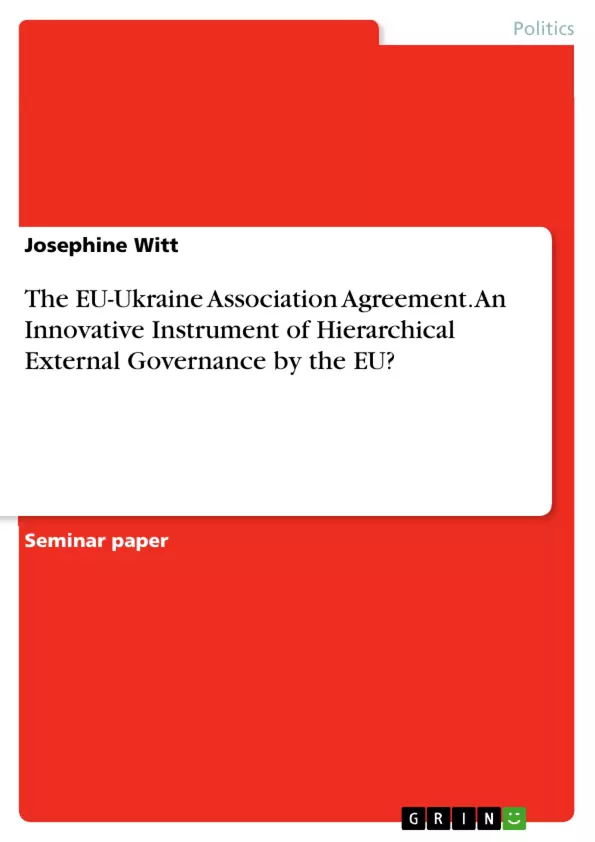This paper argues that the Association Agreement (AA) between the EU and the Ukraine that includes the establishment of a Deep and Comprehensive Free Trade Area (DCFTA) is a prominent example of EU External Governance as it is an unprecedented, innovative legal instrument that will lead to the adoption of a large part of EU laws into Ukrainian national law. The paper hypothesised that the mode of this External Governance relation is rather hierarchical than network- or market-based.
The AA with Ukraine served as a template for similar agreements with Moldova and Georgia and replaces the outdated Partnership and Cooperation Agreements (PCA) with these countries. It recently shifted into the focus of the public in the light of the dramatic events in the Ukraine, starting with the unexpected refusal to sign the Agreement by Ukraine´s former President Yanukovych in the late 2013. As such alone, it attracts the interest of scholars of International Relations and European Foreign Policy already. Furthermore, it is of significance to the EU itself. Former President of the European Council Van Rompuy had called it “the most advanced agreement of its kind ever negotiated by the European Union”. Therefore, analysing this Agreement more in detail is crucial to understanding new EU external policies towards its neighbours.
After an explanatory introduction to the notion of External Governance as a theoretical basis, the paper will try to assess the EU-Ukraine Association Agreement more in-depth. After a short overview over the genesis of the Agreement over the last years, the paper will briefly address the internal legal basis and competencies within the EU with regard to the Agreement. Concluding this empirical chapter, this paper will point out the most important innovative legal aspects of the EU-Ukraine Agreement. These will be of relevance for the final part of this paper in which the main hypothesis − that with the Agreement, the EU is setting rules beyond its borders as part of its External Governance in a hierarchical way − will be assessed. In the concluding section, the findings of the paper will be summarized.
Inhaltsverzeichnis (Table of Contents)
- Introduction
- The External Governance Approach
- The EU-Ukraine Association Agreement
- Genesis of the Agreement
- EU legal basis and competencies
- The Association Agreement – an innovative legal instrument
- The EU Association Agreement with Ukraine – a hierarchical mode of EU External Governance?
- Conclusion
Zielsetzung und Themenschwerpunkte (Objectives and Key Themes)
This paper aims to analyse the EU-Ukraine Association Agreement (AA) through the lens of the External Governance Approach, arguing that it is a hierarchical mode of EU external governance. The paper examines the agreement's origins, legal framework, and innovative features, emphasizing the EU's role in influencing Ukrainian legislation and policy.
- The External Governance Approach and its different modes
- The genesis and legal basis of the EU-Ukraine Association Agreement
- The innovative features of the Association Agreement, particularly its conditionality and scope
- The application of the External Governance Approach to the EU-Ukraine Association Agreement
- The potential implications of the Association Agreement for EU external relations and Ukrainian autonomy
Zusammenfassung der Kapitel (Chapter Summaries)
- Introduction: The paper introduces the concept of ‘Enlargement Fatigue’ and the subsequent development of the European Neighbourhood Policy (ENP) as an alternative to EU membership for neighboring countries. The paper then introduces the External Governance Approach, developed by Lavenex and Schimmelfennig, as a theoretical framework for analyzing the EU's influence on non-member states.
- The External Governance Approach: This chapter provides a detailed explanation of the External Governance Approach, outlining its key elements and the three modes of governance: hierarchical, network, and market-based. The chapter discusses the strengths and limitations of the concept as an analytical tool.
- The EU-Ukraine Association Agreement: This chapter traces the genesis of the Agreement, highlighting its significance as a replacement for the outdated Partnership and Cooperation Agreements (PCAs). It explores the legal basis and competencies within the EU for negotiating and concluding such agreements. The chapter concludes with a detailed examination of the innovative legal features of the Agreement, emphasizing its comprehensive scope, complexity, and conditionality.
- The EU Association Agreement with Ukraine – a hierarchical mode of EU External Governance?: This chapter applies the External Governance Approach to the EU-Ukraine Association Agreement, analyzing whether it constitutes a hierarchical mode of governance. It examines key elements of the Agreement, such as the conditionality approach, the unilateral harmonization of Ukrainian legislation, and the monitoring mechanisms, to support the hypothesis of a hierarchical relationship.
Schlüsselwörter (Keywords)
The main keywords of this text include: External Governance, EU-Ukraine Association Agreement, Deep and Comprehensive Free Trade Area (DCFTA), European Neighbourhood Policy (ENP), conditionality, legislative approximation, harmonization, hierarchy, network, market, sovereignty, integration, rule transfer.
- Quote paper
- Josephine Witt (Author), 2015, The EU-Ukraine Association Agreement. An Innovative Instrument of Hierarchical External Governance by the EU?, Munich, GRIN Verlag, https://www.grin.com/document/321401



